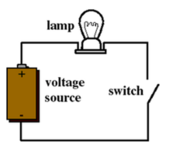Quick Look
Grade Level: 7 (6-8)
Time Required: 1 hour
Expendable Cost/Group: US $2.00
Group Size: 0
Activity Dependency: None
Subject Areas: Science and Technology

Summary
Students gain a basic understanding of electrical circuits. They build wire circuits and pass paperclips through the mazes, trying not to touch the wires. Touching a wire with a paperclip causes the circuit to close, which activates an indicator.Engineering Connection
We use circuits every day in household appliances from computers and radios to ovens and refrigerators. One of the most important circuits we use each day is that of a light bulb. Understanding electrical circuits is the basis of electrical engineering.
Learning Objectives
To understand how electrical circuits work
Educational Standards
Each TeachEngineering lesson or activity is correlated to one or more K-12 science,
technology, engineering or math (STEM) educational standards.
All 100,000+ K-12 STEM standards covered in TeachEngineering are collected, maintained and packaged by the Achievement Standards Network (ASN),
a project of D2L (www.achievementstandards.org).
In the ASN, standards are hierarchically structured: first by source; e.g., by state; within source by type; e.g., science or mathematics;
within type by subtype, then by grade, etc.
Each TeachEngineering lesson or activity is correlated to one or more K-12 science, technology, engineering or math (STEM) educational standards.
All 100,000+ K-12 STEM standards covered in TeachEngineering are collected, maintained and packaged by the Achievement Standards Network (ASN), a project of D2L (www.achievementstandards.org).
In the ASN, standards are hierarchically structured: first by source; e.g., by state; within source by type; e.g., science or mathematics; within type by subtype, then by grade, etc.
International Technology and Engineering Educators Association - Technology
-
There is no perfect design.
(Grades
6 -
8)
More Details
Do you agree with this alignment?
-
Apply a product, system, or process developed for one setting to another setting.
(Grades
6 -
8)
More Details
Do you agree with this alignment?
State Standards
Massachusetts - Science
-
Given a design task, identify appropriate materials (e.g., wood, paper, plastic, aggregates, ceramics, metals, solvents, adhesives) based on specific properties and characteristics (e.g., strength, hardness, and flexibility).
(Grades
6 -
8)
More Details
Do you agree with this alignment?
Materials List
- 5 m stripped wire
- 1 pair wire cutters
- 1 battery
- 1 noise maker or light
- 1 metal paper clip
Introduction/Motivation
Electrical engineers work with anything that carries electricity. Computers are primarily designed by electrical engineers. In this activity, we will explore the concept of closed circuits. We will use the materials given to design a maze. The object is to not touch the wire with the paper clip as you pass it over the maze. When you touch the maze with the paperclip a sound (or light) signals that the circuit has been closed.
Procedure
- Assemble the wire in the desired shape leaving a strand of wire on each end of the maze.
- Take one end of the wire from the maze and connect it to the battery.
- Take the other end and thread the paperclip onto the wire and then connect with wire to the noise maker or light.
- Connect the battery to the noise maker or light.
- Move the paper clip around the wire, trying not to touch the wire.
Assessment
Investigating Questions Homework: Ask students the Investigating Questions and ask them to write up possible options/solutions as homework.
Investigating Questions
- Could you set this up differently and still have it work?
- Could you do this with wire that was covered?
Subscribe
Get the inside scoop on all things TeachEngineering such as new site features, curriculum updates, video releases, and more by signing up for our newsletter!More Curriculum Like This

Students learn that charge movement through a circuit depends on the resistance and arrangement of the circuit components. In one associated hands-on activity, students build and investigate the characteristics of series circuits. In another activity, students design and build flashlights.
Copyright
© 2013 by Regents of the University of Colorado; original © 2005 Worcester Polytechnic InstituteSupporting Program
K-12 Outreach Office, Worcester Polytechnic InstituteLast modified: June 1, 2021






User Comments & Tips